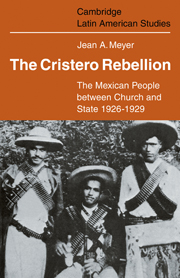Book contents
- Frontmatter
- Contents
- List of illustrations
- Preface
- Chronology of events
- List of abbreviations
- PART I THE CONFLICT BETWEEN CHURCH AND STATE
- PART II THE CRISTEROS
- 5 Church Folk and Townsfolk
- 6 The Recruitment of the Cristeros
- 7 The Cristero Army
- 8 Cristero Government
- 9 The War
- 10 Culture and Religion, Faith and Ideology
- PART III AFTER THE PEACE
- Envoi
- Notes
- Bibliography
- Index
5 - Church Folk and Townsfolk
Published online by Cambridge University Press: 05 April 2013
- Frontmatter
- Contents
- List of illustrations
- Preface
- Chronology of events
- List of abbreviations
- PART I THE CONFLICT BETWEEN CHURCH AND STATE
- PART II THE CRISTEROS
- 5 Church Folk and Townsfolk
- 6 The Recruitment of the Cristeros
- 7 The Cristero Army
- 8 Cristero Government
- 9 The War
- 10 Culture and Religion, Faith and Ideology
- PART III AFTER THE PEACE
- Envoi
- Notes
- Bibliography
- Index
Summary
The Bishops, Rome, and the Armed Struggle
The bishops, when they chose the path of resistance to the Government, were counting on the fidelity of the Catholics, and their hopes were not betrayed. The collective pastoral letter of 21 April 1926 contained the words ‘the moment has come to say NON POSSUMUS’, and that of 25 July asserted that ‘it would be criminal on our part to tolerate such a situation’; on 12 September, when the conflict had begun in earnest, a further letter exhorted the faithful to ‘imitate the constancy of the early Christians … who died like good men, and their blood was the seed of new converts’.
At the same time, the bishops made it clear that they did not desire any form of resistance that was not passive and peaceful. The impetuous Mgr Manríquez, who was later to become a supporter of the Cristeros, three times in the period 1925–6 forbade recourse to violence, and the other bishops did the same. It was, in fact, the episcopal decision to suspend public worship that unleashed the Cristiada, but the bishops were not formally responsible.
In the face of the fait accompli of the Cristero rising, the Church reacted with the utmost prudence, and did so at first in the theological sphere. Many of the insurgents had first consulted their parish priests as to the legitimacy of the insurrection; the parish priests in turn consulted the bishops, who handed the problem over to the theologians.
- Type
- Chapter
- Information
- The Cristero RebellionThe Mexican People Between Church and State 1926–1929, pp. 67 - 82Publisher: Cambridge University PressPrint publication year: 1976



